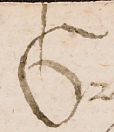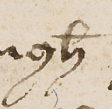|
| A |
 | Usage: blame
secretary 'a' always used as lower case letter. |  | Usage: and
where 'a' is a stand-alone graph there is frequently an extension of the hairline stroke forming the top of the graph. |
 | Usage: A |  | Usage: And-An
the scribe has several variations of his upper case 'A' graph. |
|
| D |
 | Usage: syde
looped 'd' is used with point at the left of the lower lobe and a backward sloping loop. |  | Usage: delectabyl |
 | Usage: lovid
'd' in final position with tag extension on the stroke closing the loop. |  | Usage: Downe
upper case 'D'. |
|
| G |
 | Usage: gentillest
the usual formation of 'g' with extended tail turning counter-clockwise to form a loop. |  | Usage: yong
'g' in final position with hook to finish the horizontal slash. It could represent a missing final 'e'. |
 | Usage: thyng(es)
'g' with 'es' abbreviation mark. |  | Usage: Grysill
upper case 'G' for the running title. |
|
| H |
 | Usage: haboundant
tail-stroke flicks to the right. |  | Usage: Ther
tail-stroke turns counter-clockwise and retraces the angle and path of the original descending stroke. |
 | Usage: ynough
in 'th', 'gh', 'ght' combinations in final position, 'h' is always crossed. |  | Usage: hyght
the tails of 'y', 'g' and 'h' are uniform. |
|
| R |
 | Usage: Ther
'z'-shaped 'r' used almost all the time. |  | Usage: wher
a single occurrence on the two folios sampled of modern 'r' in final position with flourish. |
 | Usage: Rote | | |
|
| S |
 | Usage: is
kidney-shaped 's' in final position. |  | Usage: considred
long 's' used initially and in medial position. |
 | Usage: Slus
upper case 'S'. | | |
|
| W |
 | Usage: weren
the same basic shapes of 'w' are repeated in the upper case versions. |  | Usage: was
the left arm of 'w' extends way above the remainder of the graph. |
 | Usage: Wher
upper case letter at the beginning of a line. The same as the lower case version in 2. | | |
|
| Y |
 | Usage: syde
the tail of 'y' is long. It turns counter-clockwise and retraces the angle of the descending stroke. | | Usage: many
sometimes the tail of 'y' is taken back and up through the body of the letter. |
 | Usage: worthy | | |
|
| Thorn |
 | Usage: þt
thorn is mainly used where the scribe can abbreviate the word with superscript letters. |  | Usage: þu
the stem of thorn is a short vertical stroke. It is open at the head. |
 | Usage: þe |  | Usage: þis |

































